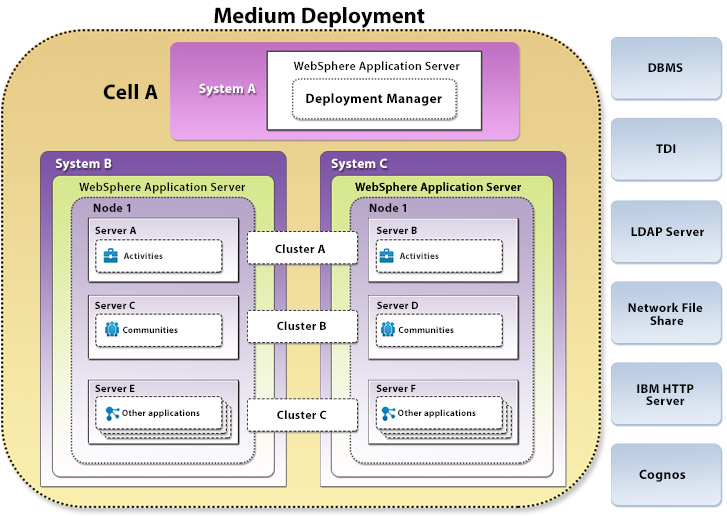Connections deployment options
- Small deployment
- Install all Connections applications on a single node in a single cluster. All the applications run within a single JVM.
The diagram depicts a topology with up to 8 servers. If we install the servers on shared systems, you do not need to deploy 8 separate systems.

- Medium deployment
- Install a subset of applications in separate clusters. IBM Connections provides three predefined cluster names shared among all of its applications. Use this option to distribute applications according to the usage expectations. For instance, you might anticipate higher loads for the Profiles application, and install it in its own cluster, while other applications could be installed in a different cluster.

- Large deployment
- Install each application in its own cluster. IBM Connections provides a predefined cluster name for each application. In most cases, install the News and Home page applications in the same cluster.

In a multi-node cluster, configure network share directories as shared content stores.
If using NFS, use NFS v4 because NFS v3 lacks advanced locking capability. If using Microsoft SMB Protocol for file-sharing, use the UNC file-naming convention; for example:
-
\\machine-name\share-name
For shared and remote network file system requirements, review the footnotes for each supported OS.
We can assign various combinations of applications to clusters. For more information, visit the Connections wiki.
For failover, have two JVMs per application, or two nodes for each cluster, scaled horizontally.
Vertical scaling is not officially supported in Connections.
For enhanced performance and security, consider using a proxy server in the deployment.
IBM Cognos Business Intelligence is an optional component in the deployment. If used, federate Cognos to the same dmgr as the Connections servers. Cognos servers cannot be configured within a Connections cluster. Cognos BI does not have to be deployed before installing the Metrics application.
Even if you do not plan to deploy Cognos now, install the Metrics application so that events are recorded in the Metrics database for use when Cognos is available to provide reports.
For added security with 3rd party OpenSocial gadgets, such as those from iGoogle, configure locked domains, which isolate these gadgets from intranet and SSO information:
- A second top-level domain that is not in the SSO domain.
For example, if the SSO domain is myco.com, create a distinct top level domain such as example-modules.com.
- A wild card SSL certificate for the domain name.
No additional server instances are required for the basic configuration.
Parent topic:
Planning
Related:
Troubleshooting techniques
Configure file downloads through IBM HTTP Server
Install as a non-root user
Install IBM WebSphere Application Server
Set up federated repositories
Before installing for migration